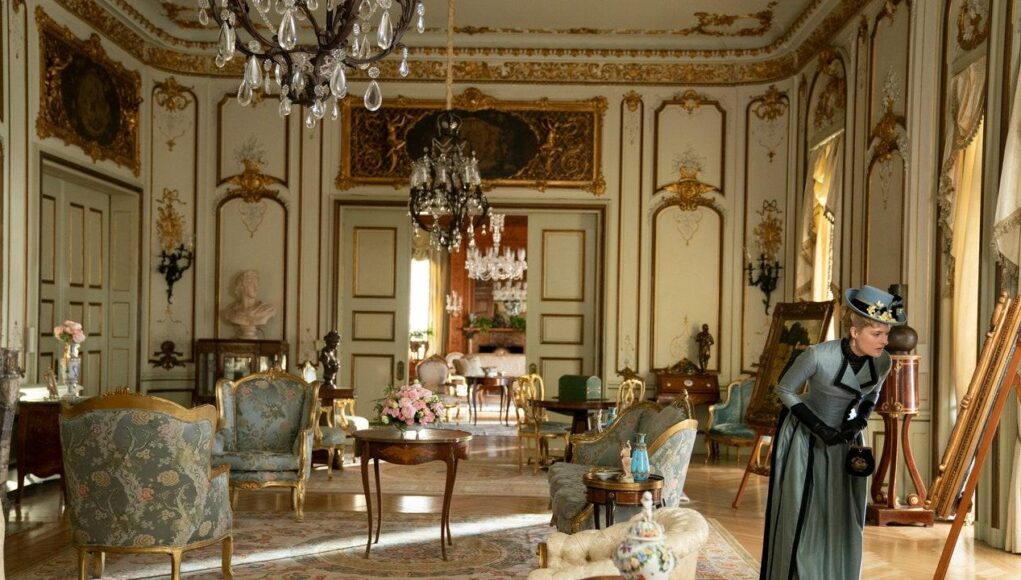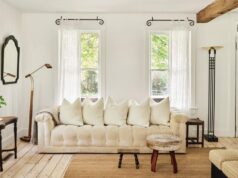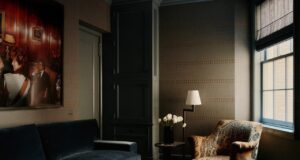If you’ve been watching Julian Fellowes’s lavish new series The Gilded Age, set in New York in the final decades of the 19th century and featuring much marble, many digs about new money, and real historical characters combined with fictional creations, you might wonder at its similarity to certain of Edith Wharton’s novels. The truth is that it was the Pulitzer-prize-winning Wharton—and most particularly The Custom of the Country, her novel about a ruthless social climber—who inspired Fellowes to be a writer. But Wharton’s first book, co-written with Ogden Codman, the architect she employed to work with her on her house in Newport, Rhode Island, was a treatise on decorating houses, entitled, simply, The Decoration of Houses. An ode to nobility, grace and timelessness, her ideas about proportion and simplicity are still the bedrock of any scheme, and the book has been described as the equivalent of the King James version of the Bible.
But first, Newport, where we saw Larry Russell pretending to play croquet in the first episode of The Gilded Age, having been tasked by his calculatingly ambitious mother with befriending Carrie Astor (a real person; the Russells, meanwhile, are based on the Vanderbilts, who were dependent on Mrs. Astor’s acceptance if they were to achieve their aims of joining the crème of New York society). Between the years of 1870 to 1910 or so, Newport’s waterfront was where some of the world’s wealthiest people owned summer ‘cottages’, and it is those houses that have been used for many of The Gilded Age interior scenes.
The Russells’ Manhattan ballroom is in fact the music room at The Breakers, the Renaissance-style palace built by Cornelius Vanderbilt II and his wife Alice, designed by architect Richard Morris Hunt (also a real person; though the fictional Russells did not use him, but Stanford White—again real—who genuinely designed Fifth Avenue mansions before being murdered at the Madison Square Theatre). The room itself was made in France, and then shipped over in the 1890s. Filming has also taken place at The Marble House, built by William K. Vanderbilt and his wife, Alva, to outshine The Breakers, also using Hunt. Modeled on the Temple of the Sun at Heliopolis, only bigger, the façade was made from 500,000 cubic feet of white marble, while the dining room was modeled after the Palace of Versailles’s Salon of Hercules, and the ballroom after its Hall of Mirrors.
While neither The Breakers nor The Marble House were influenced by Wharton’s book—they were finished before The Decoration of Houses was published 1897—there’s a chance that they inspired certain passages, for her ideas on the dangers of the new (and their behaviour) at face value look similar to Agnes van Rhijn’s; “The vulgarity of current decoration has its source in the indifference of the wealthy to architectural fitness,” she wrote.
In fact, Wharton left Newport in 1899 when the view from her elegant octagonal sunroom was compromised by the construction of a house by a designer who clearly had not yet absorbed her design principles. And yet the ‘new’ that Wharton abhorred was the oppressive Victoriana of the time, and we think she might rather have admired the Russells/ Vanderbilts. (Though Consuelo Vanderbilt, daughter of Alva and William—who might therefore be Gladys Russell in Fellowes’s series—did not like Wharton. She wrote about meeting her in The Glitter and the Gold and complained that Wharton was studying her in a forensic fashion. Which, of course, she was.) Either way, there’s a good game of Edith Wharton bingo to be played while watching The Gilded Age, according to the rules below.
Settle for only the best…
Use and buy the best you can afford—and if you can afford it, it is your civic duty: “When a rich man demands good architecture his neighbours will get it too. . . Every good moulding,” writes Wharton, “every carefully studied detail, exacted by those who can afford to indulge their taste, will in time find its way to the carpenter-built cottage.” The Russells, obviously, have complied with this. Those society ladies really should have used their ballroom for that fair.
…but be outwardly modest
And yet . . “In town houses especially all outward show of richness should be avoided; the use of elaborate lace-figured curtains, besides obstructing the view, seems an attempt to protrude the luxury of the interior upon the street.” We don’t know what Wharton thought of the magnificent facades of those Newport cottages. Perhaps this rule didn’t apply by the sea, or only applied to curtains? Either way, these days billionaires have their houses removed from Google Street View, which could be seen as the modern equivalent.
Originality is key
“It seems easier to most people to arrange a room like someone else’s than to analyse and express their own needs. Men, in these matters, are less exacting than women, because their demands, besides being simpler, are uncomplicated by the feminine tendency to want things because other people have them, rather than to have things because they are wanted.” In other words, stop aspiring to whatever others have got. If the Russells could employ Stanford White—who, if we’re going to look at reality again, hadn’t yet designed any major buildings in New York at that time, only a Methodist Church in Baltimore—then we too can march to our own tune and arrange our houses according to how we want to live, and “the more closely we follow this rule the easier our rooms will be to furnish and the pleasanter to live in.”
Some rules can’t be broken
That said, there are universal regulations, which according to Wharton include avoiding unnecessary window dressings, ensuring privacy is afforded via doors that close (no open plan for her; also, doors should swing into a room, and screen the part of the room in which the occupants usually sit) and making sure tables are not “so littered with knick-knacks” that there isn’t room for books. She remarks that the drawing room in some houses “is still considered sacred to gilding and discomfort” and complains about the modern upholsterer who “pads and puffs his seats as though they were to form the furniture of a lunatic’s cell.” She also loathed extendable dining tables.
Don’t overload your rooms with color
Next, “the fewer the colors used in a room, the more pleasing and restful the result will be. A multiplicity of colors produces the same effect as a number of voices talking at the same time. . . . continuous chatter is fatiguing in the long run.” Additionally, Wharton advised using the same materials for curtains and chair-coverings, which “produces an impression of unity and gives and air of spaciousness to the room.”
We’re not sure the Van Rhijn house would pass; there are definitely rooms that have curtains in a different shade to the walls, and there’s a sofa that is a different color again. But worst are the stairs, which appear to have a patterned carpet. “It is fatiguing to see a design meant for a horizontal surface constrained to follow the ins and outs of a flight of steps.” We’re not totally with Wharton on all of this.
Marble is king
Marble was a favorite material, and, Wharton wrote, ideal for floors, walls, bathrooms—well, everything. So perhaps the façade of The Marble House did pass muster, with its roughly $2.7 million of white marble shipped from a quarry near the Hudson river. The house also used yellow marble from Montagola in Italy (it lines the entrance hall) and pink Numidian marble that came from Algeria.
Don’t forget the children
We haven’t yet seen any nurseries or schoolrooms in The Gilded Age, but Wharton was adamant regarding the importance of their (good) design. “The room where the child’s lessons are studied is, in more senses than one, that in which he receives his education. . . . Daily intercourse with poor pictures, trashy ‘ornaments,’ and badly designed furniture may, indeed, be fittingly compared with a mental diet of silly and ungrammatical story-books.” Which is a wise lesson for all of us with progeny and all the more reason to make sure their bedrooms offer beauty.
Each room has a proper purpose
Finally, the decoration of ballrooms and music rooms, which should be “quite separate from the family apartments, either occupying an entire floor or being so situated that it is not necessary to open them except for general entertainments.” Within this is essentially the lesson that each room should have its own purpose. “Nothing can be more cheerless than the state of a handful of people sitting after dinner in an immense ball-room with gilded ceiling, bare floors, and a few pieces of monumental furniture ranged around the walls; yet in any house which is simply an enlargement of the ordinary private dwelling the hostess is often compelled to use the ballroom as a drawing room.”
Wharton was also more generous when it came to decorating a ballroom or a music room than she was with other parts of the house—it was the one place that you were allowed to go to town with moldings and gilding and painted ceilings and all the rest. We’re yet to see the Russell’s magnificent example in action, but we do know that Mrs. Vanderbilt was eventually called on by Mrs. Astor when she gave a ball so grand and so magnificent that Carrie Astor was desperate to attend. There’s a reason those decades became referred to as the Gilded Age, and we’ve a feeling there are a lot more good interiors to come.
This article originally appeared in House & Garden UK.








